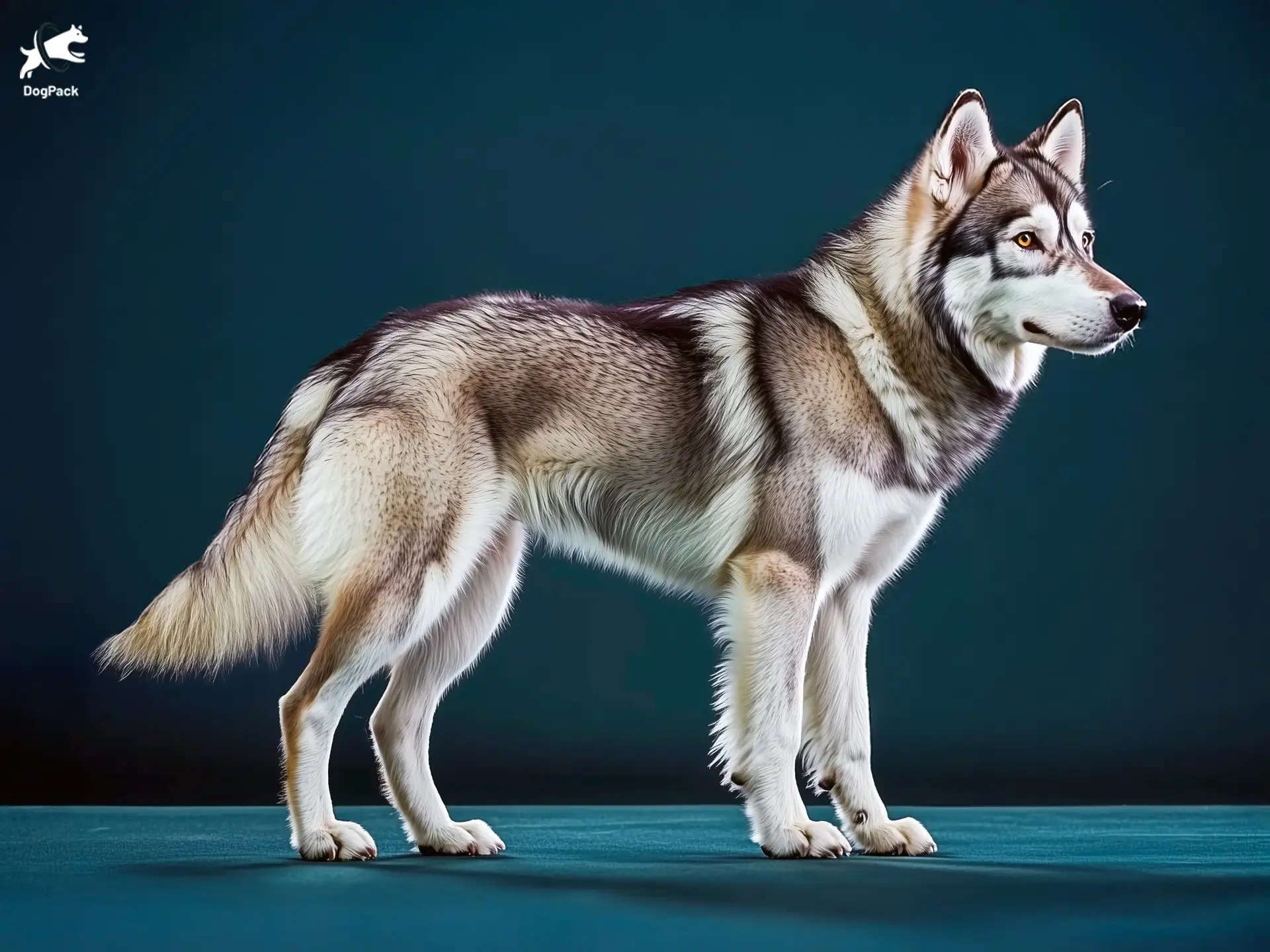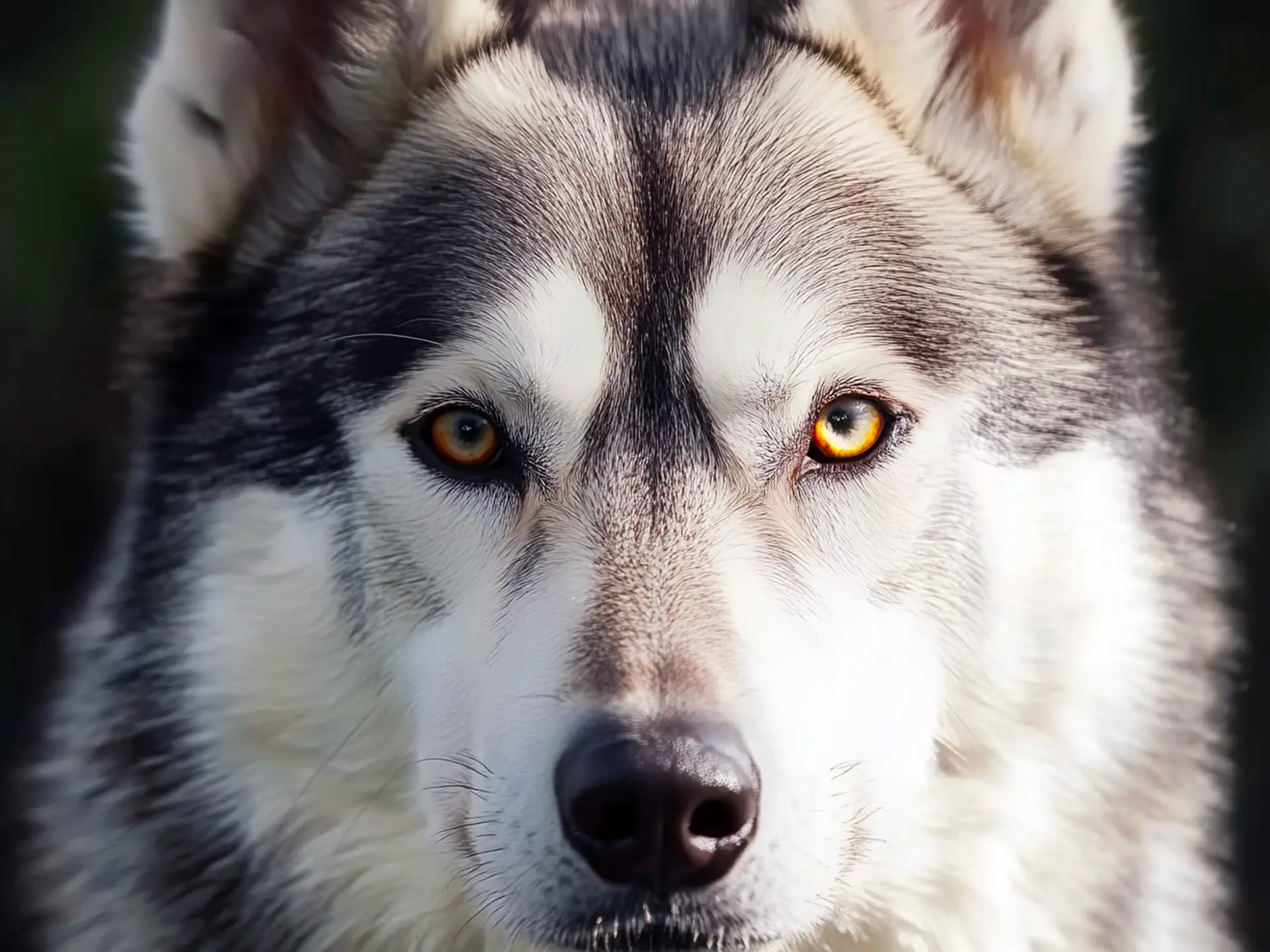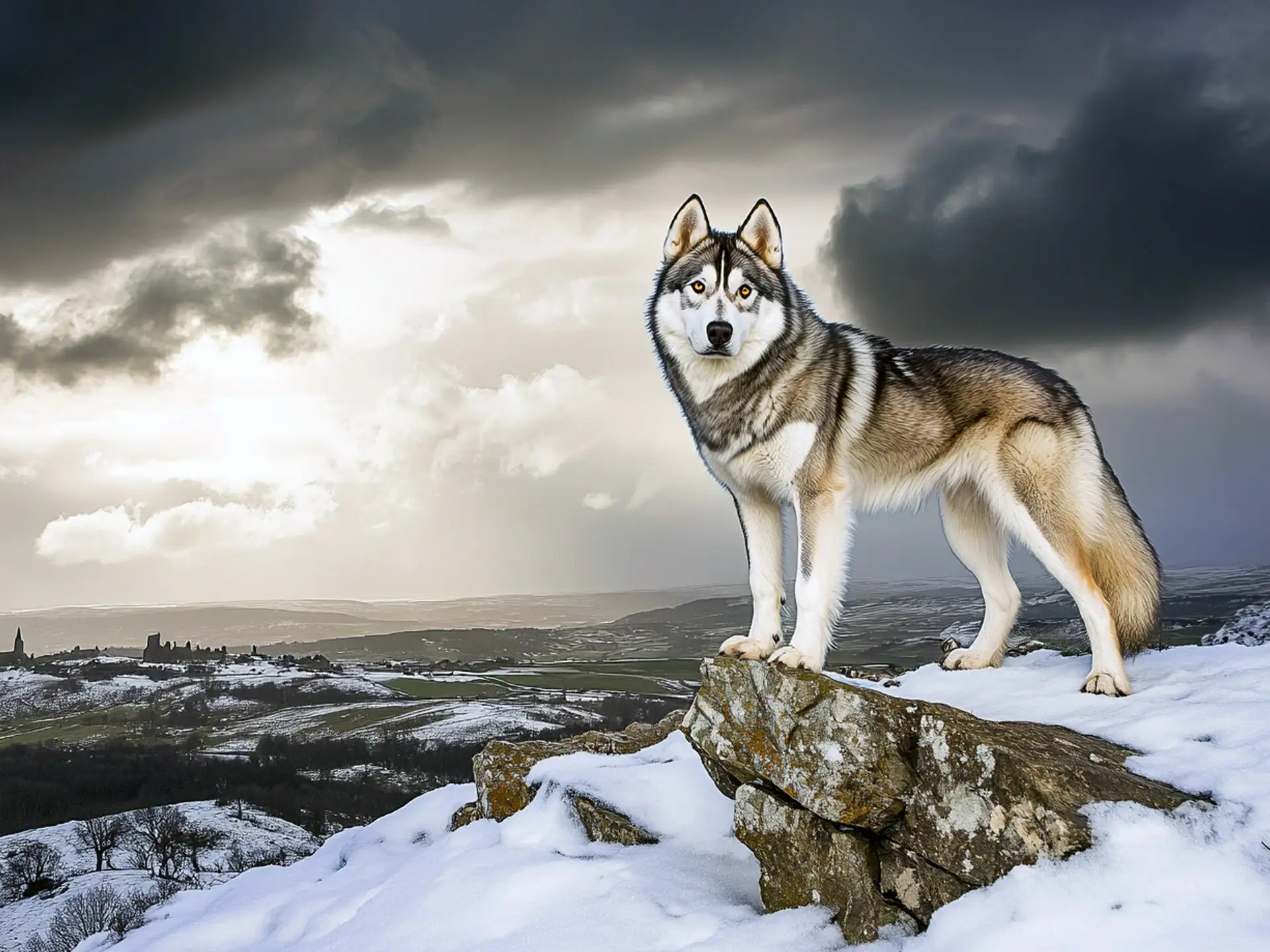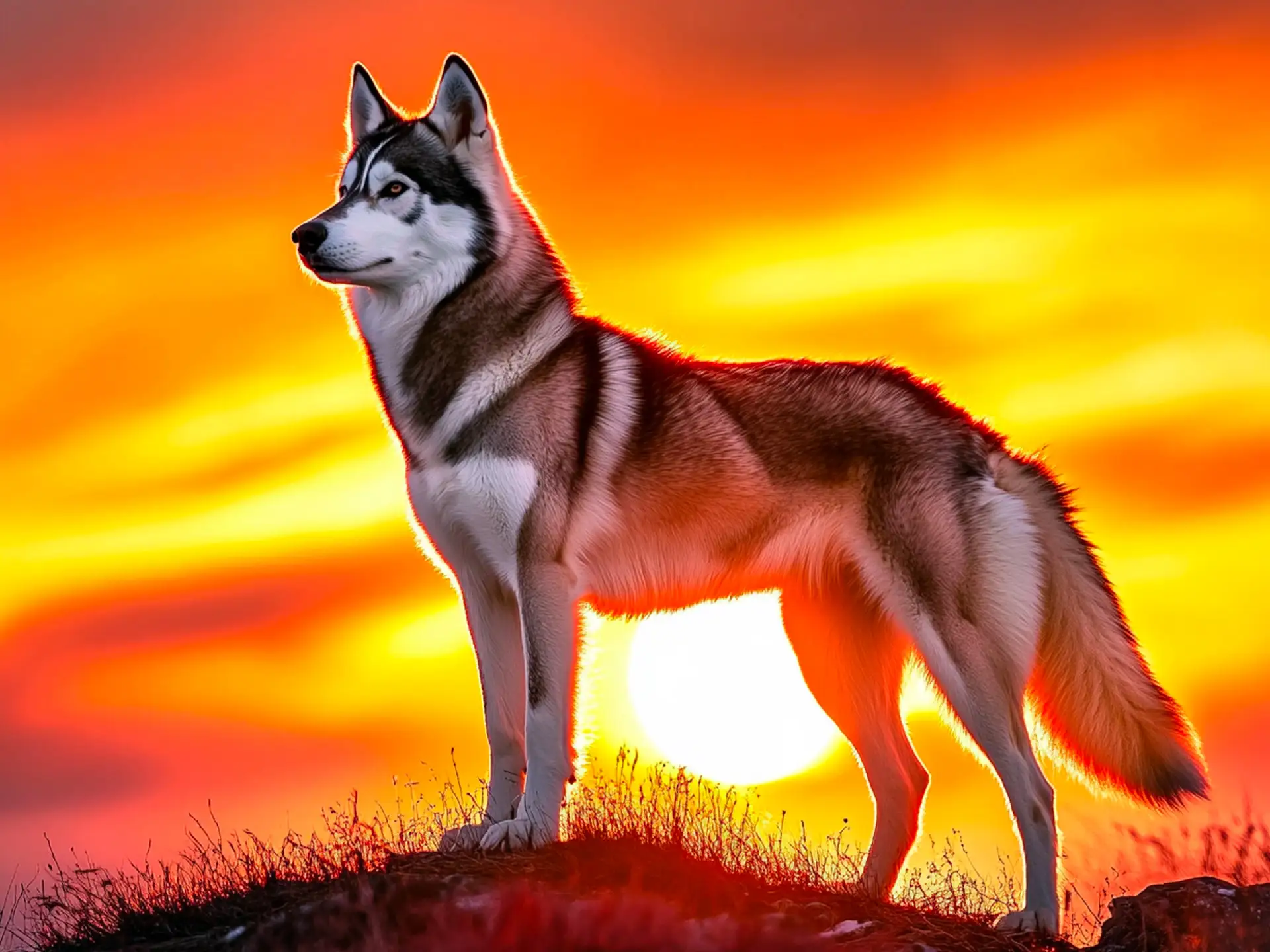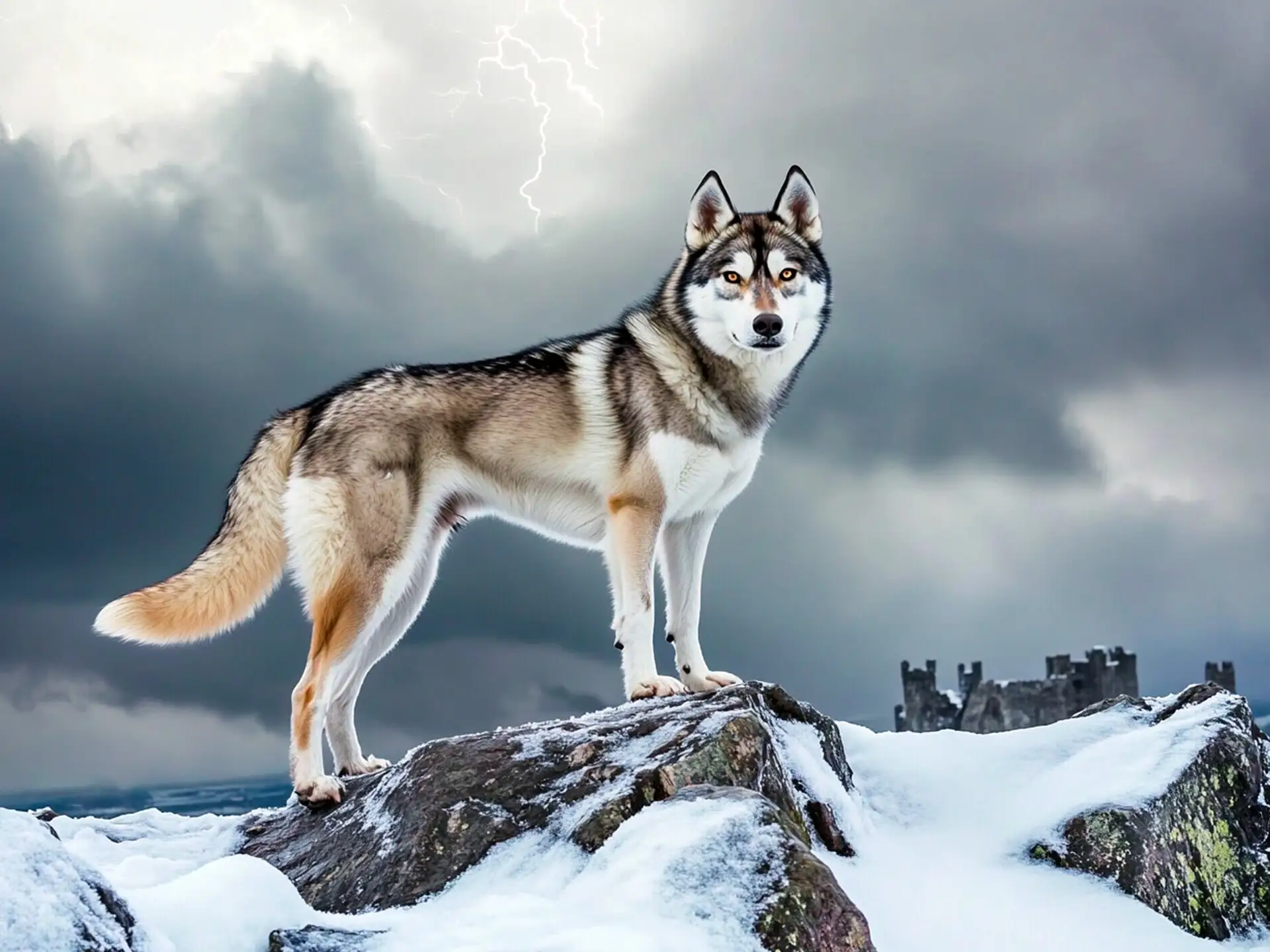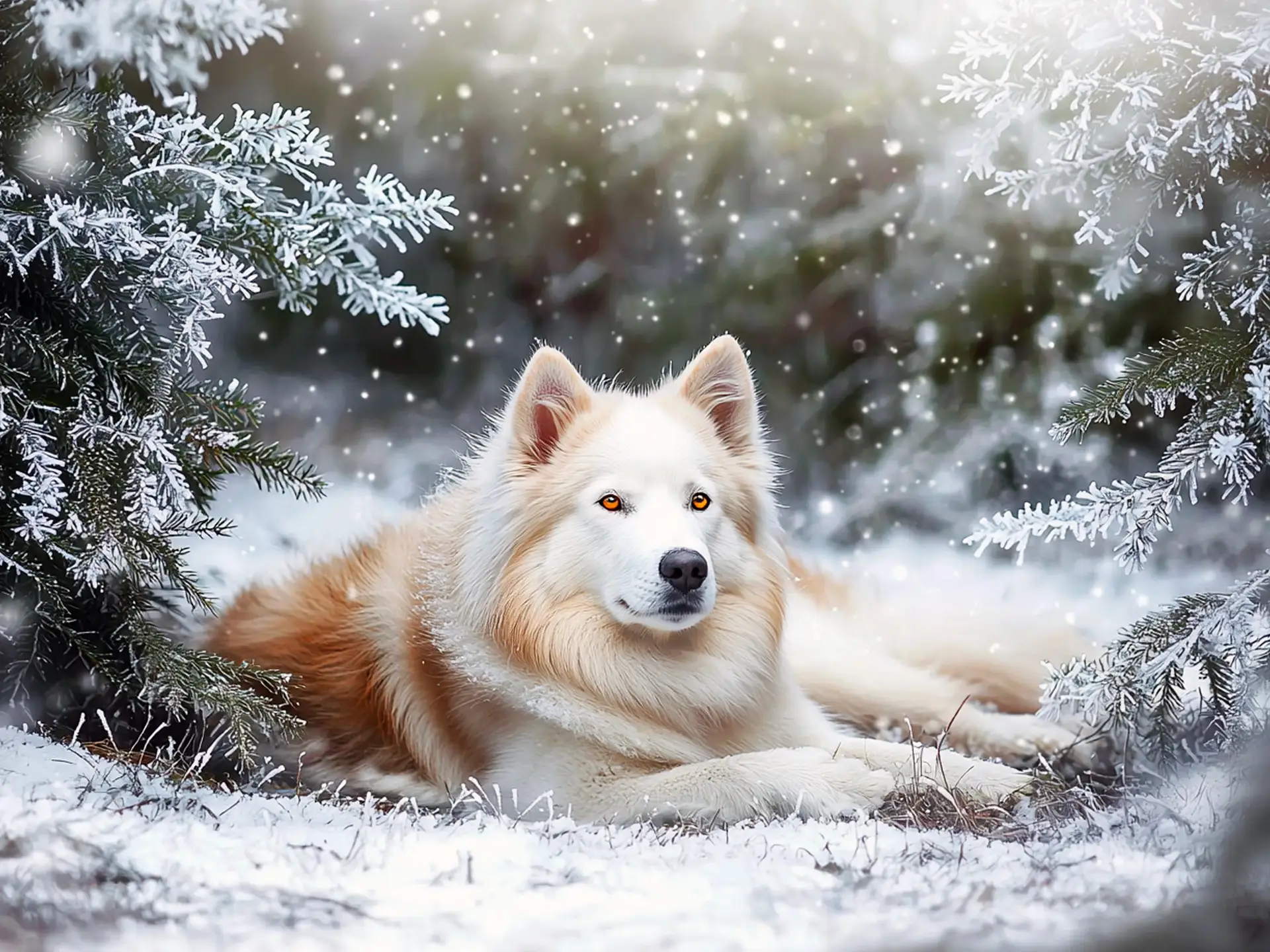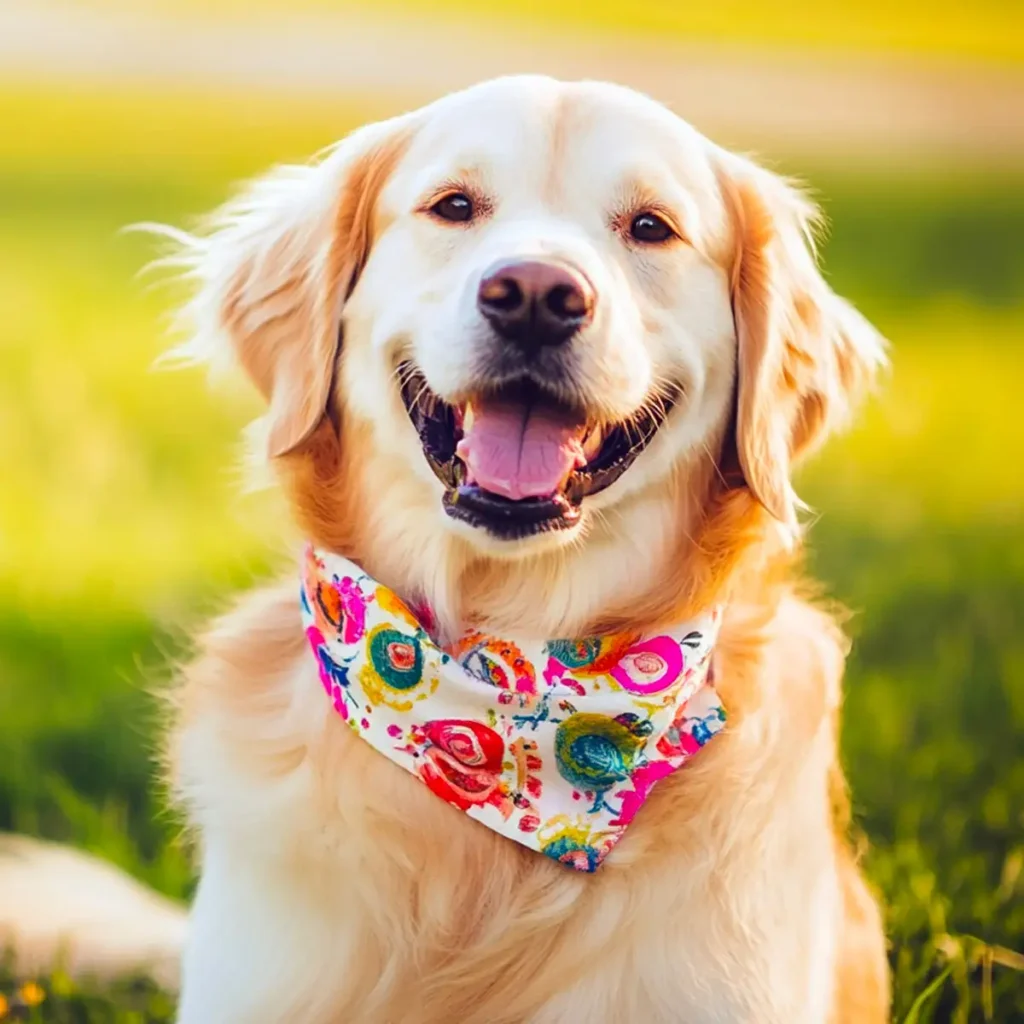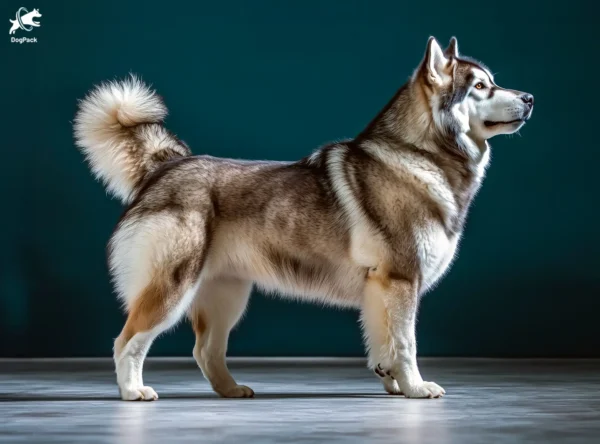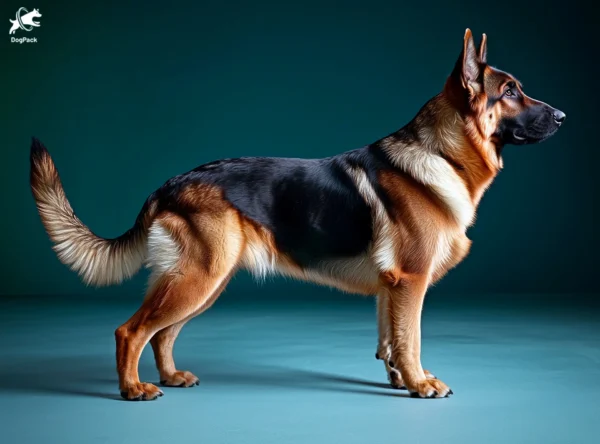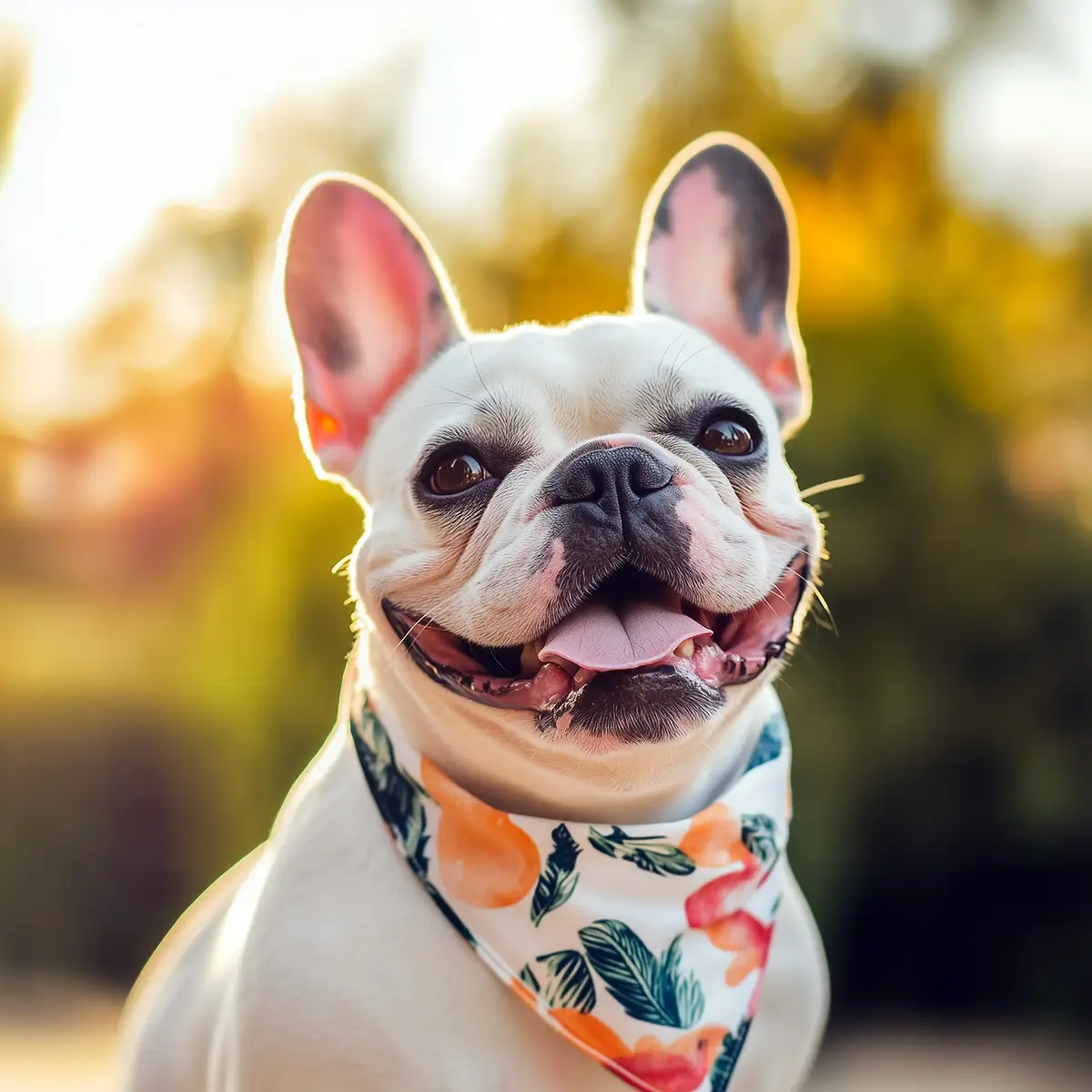Northern Inuit Dog Breed Info & Overview
The Northern Inuit Dog, with its wolf-like appearance and friendly, family-oriented demeanor, is a captivating hybrid breed. Known for its striking gaze and spirited loyalty, this rare canine combines the mystique of a wolf with the playful charm of a devoted companion. Perfect for outdoor enthusiasts, the Northern Inuit Dog thrives in active settings, making it a truly unique and adventurous addition to any family.
Characteristics
Pictures
Breed History
Brought to prominence by canine enthusiasts in the UK, this striking wolf-like dog owes its lineage to crossbreeding Siberian Huskies, Alaskan Malamutes, and German Shepherds. The aim was to create a balanced companion with the look of a wild canine but the temperament of a domesticated pet. It’s said the original lines surfaced around the 1980s. If you’re intrigued, learn about other rare dog breeds.
Over time, fanciers carefully refined the breed for health, intelligence, and a family-friendly disposition. Many fans adore their regal appearance and claim they channel the spirit of ancient wolves. These dogs have even starred on the small screen, doubling for wolves in popular TV series, showcasing both their flair and adaptability as they capture hearts worldwide.
Today, devotees continue to shape this unique bloodline, ensuring consistency and robust health. Various breed clubs have formed, promoting responsible ownership and the prevention of unethical breeding practices. The Northern Inuit Dog remains relatively rare, yet it has steadily gained loyal fans who appreciate its blend of aesthetic appeal and gentle nature.
Temperament, Personality
Adventurous and full of life, these dogs thrive in active households where they can satisfy their curiosity. They often bond strongly with their families, showing unwavering devotion and a willingness to follow their favorite humans around. Despite their independent streak, they typically relish companionship and may grow anxious if left alone for extended periods.
Thanks to their social genes, they tend to get along well with older children, though supervision is key when introducing them to little ones. They might be aloof toward strangers at first, but with proper socialization, they become polite and approachable. Early introductions to different environments and creatures ensure they grow into well-rounded canines.
On the mischievous side, these pups are known for cheeky antics if not given enough mental stimulation. With the right guidance, they’re more than willing to please. Northern Inuit Dog owners often gush about how affectionate these dogs can be once they trust you, curling up for a cuddle after a day of energetic adventure.
Physical Characteristics
Standing tall with a lean yet muscular build, these dogs command attention. Their wedge-shaped heads, upright ears, and bushy tails all contribute to their sleek, wolf-inspired appearance. A thick double coat, often in shades of gray, black, or sable, keeps them comfortable in cooler climates. Their eyes can be brown or amber, adding to their captivating gaze.
Underneath that wild allure lies a sturdy frame built for endurance. They can move with a graceful, long-strided trot, reminiscent of their wolf cousins. While their look might be intimidating to some, many folks find their gentle expression inviting and friendly. It’s not uncommon for passersby to pause and inquire about their fascinating heritage.
The Northern Inuit Dog isn’t just about looks—there’s genuine substance behind that dramatic exterior. Considered a medium- to large-sized breed, they can easily reach above 70 pounds, sporting well-defined muscles across their limbs and chest. Owners who enjoy outdoor activities will love how these dogs seem at home in rugged terrains, ready for the next hike or adventure. For more big pups, check out these large dog breeds.
Health Issues
Being a relatively new hybrid, these dogs may inherit certain conditions from their parent breeds, including hip dysplasia and certain eye disorders. Regular vet checkups and genetic screenings can help manage or prevent serious problems. Early detection is key, especially for orthopedic concerns that can impact mobility and comfort later in life.
It’s also important to monitor their immune system, as some lines might show susceptibilities to autoimmune diseases. A balanced diet and consistent exercise routine can go a long way in maintaining overall vitality. Owners sometimes report issues like bloat or gastric torsion, so keeping a watchful eye on feeding habits and meal schedules is essential.
Though the Northern Inuit Dog is generally sturdy, routine wellness checks are non-negotiable. Preventive measures like flea and tick control, as well as heartworm medication, further protect your companion. Paying attention to subtle changes in behavior—such as lethargy or loss of appetite—lets you catch health hiccups early, ensuring a long and content life by your side.
Grooming Needs
Those plush double coats do require a bit of elbow grease. Weekly brushing helps remove loose fur, reduces matting, and keeps the coat shiny. During shedding seasons (spring and fall), the hair can appear to fly off in all directions, so be ready to break out a deshedding tool or vacuum more often than usual.
Bathing should be occasional, as excessive washing can strip their coat of natural oils. When you do give them a spa day, use dog-friendly shampoos that won’t irritate their skin. Pay close attention to ears and nails—clean ears help avoid infections, while keeping nails trimmed prevents discomfort and potential paw injuries.
The Northern Inuit Dog thrives with routine grooming sessions that also serve as bonding time. Gently brush their fur, check for any skin issues, and reward them with praise or treats. This consistent ritual not only keeps them looking their best but also gives you a chance to spot minor problems before they become bigger issues.
Exercise Requirements
Daily walks and vigorous playtime are absolutely necessary for these energetic canines. They excel in activities like hiking, jogging, and even canine sports, where they can showcase their agility. Without adequate exercise, they may resort to less amusing pastimes—think hole-digging or creative furniture rearranging—so it’s wise to keep them mentally and physically stimulated.
A secure yard is a bonus, but they’re not the type to remain content lazing around. Their inquisitive minds and robust stamina benefit from tasks that engage both body and brain. Puzzle toys, scent games, or advanced obedience drills can all help channel their energy productively, preventing them from becoming bored or destructive.
For those dedicated owners who love the outdoors, the Northern Inuit Dog makes an enthusiastic partner. Trekking across varied terrains with a well-fitted harness is often a favorite pastime. Just remember, their thick coats can lead to overheating in hot climates—schedule walks in cooler parts of the day and provide fresh water at all times.
Training Tips
Training these bright dogs can be both rewarding and, at times, a test of patience. They respond best to positive reinforcement methods that incorporate tasty treats, praise, or play. Consistency is key—mixed signals can confuse them and slow progress. Start obedience lessons early, focusing on basic commands like ‘sit,’ ‘stay,’ and ‘come.’
Because of their independent side, harsh corrections may backfire. Instead, approach training with creativity, breaking tasks into short, fun sessions. Regular socialization from puppyhood helps them adapt to diverse environments and handle new experiences with ease. Always end on a high note, so they associate training time with something positive and rewarding.
Sometimes, a Northern Inuit Dog will test boundaries, particularly during adolescence. Firm but kind leadership ensures they respect household rules without feeling stressed. Mixing up the routine—such as introducing new commands or rotating training toys—keeps them engaged. When they realize good behavior leads to exciting outcomes, you’ll see them eagerly offering their best paw forward.
Nutrition, Diet
These large canines often require a nutrient-dense, protein-focused diet to support their active lifestyle. Many breeders recommend a diet that includes high-quality meats like turkey, chicken, or fish alongside digestible grains or vegetables. Some owners opt for a raw feeding approach, but it’s best to consult with a veterinarian knowledgeable about Northern Inuit Dog specifics before making any big changes.
When fully grown, they usually consume between 3 to 4 cups of kibble per day, split into two meals—one in the morning and one in the evening. Opt for formulas designed for large-breed dogs, ensuring balanced levels of calcium and phosphorus. This helps reduce the risk of joint problems and promotes steady growth.
Monitoring weight is crucial, particularly in younger dogs susceptible to rapid growth spurts. Overfeeding can lead to skeletal strain, so keep an eye on body condition rather than just portion sizes. If you notice your pup’s waistline disappearing, adjust accordingly. Consistency and routine in feeding times can also help ward off digestive upsets and keep meals stress-free.
Adoption, Breeders
Finding a reputable breeder can be tricky due to the breed’s rarity. Always look for someone who provides health certificates, genetic testing, and transparent breeding practices. Visiting the breeding facility and meeting the parents can offer insight into temperament and health. Steer clear of puppy mills or suspicious online listings promising “exclusive wolf dogs.”
If adoption is your preference, check local rescue groups or nationwide organizations that occasionally take in these dogs. You can also explore The Northern Inuit Society or Pets4Homes for updated listings and additional resources. Many wonderful adult dogs need forever homes, and rescue staff often know each dog’s personality, helping you find the right match.
Before bringing a Northern Inuit Dog home, ensure you’re prepared for their energy level, grooming needs, and training demands. Patience and consistency go a long way in helping them settle. Whether through a caring breeder or a rescue, doing thorough research increases the chances of finding that perfect match for your lifestyle.
Family Pet?
For a lively household that loves outdoor adventures, these dogs can be an excellent fit. They often adore romping around with older kids, but their size might be overwhelming for toddlers. It’s crucial to teach youngsters how to interact respectfully and safely—no ear pulling or tail grabbing. With a gentle approach, these pups can become affectionate family members.
Introducing them to other pets should be done slowly and under supervision. Many get along swimmingly with other dogs, although initial caution is advised. Cats can be trickier, depending on the dog’s prey drive and prior socialization experiences. Whether your household includes feline friends or not, it’s wise to plan gradual, well-managed meet-and-greet sessions that foster trust and peaceful coexistence.
Those who cherish a cozy, indoor-focused life might find the Northern Inuit Dog too energetic. They thrive in spacious environments where they can stretch their legs. If you’re dedicated to daily walks, interactive play, and mental challenges, they can become a loyal buddy who wants nothing more than to be part of the family pack.
Right For You?
Before you commit, consider your schedule and energy levels. If you enjoy hiking, jogging, or dog sports, you’ll likely love sharing your life with this breed. On the flip side, folks who prefer a couch-potato companion may find themselves overwhelmed by the dog’s exercise requirements. Make sure you can offer the stimulation they need.
Space and time are also key factors. Urban apartments might struggle to accommodate their adventurous nature, though it’s not impossible with diligent training and plenty of walks. They can be vocal if bored, so be prepared for howling sessions if your dog feels restless. Active families with fenced yards and the willingness to invest in daily activities fare best.
Ultimately, the Northern Inuit Dog demands a committed, patient guardian who appreciates both its wolf-like elegance and spirited personality. If you’re ready for the responsibilities that come with a large, inquisitive companion, you’ll be rewarded with loyalty, intelligence, and a partner eager to explore the world by your side.
Conclusion
Striking a balance between wild allure and a family-friendly nature, this breed isn’t for everyone. Yet for those who can meet its exercise and training requirements, the Northern Inuit Dog can be a wonderful partner in adventure. Their intelligence shines through in everything they do, and their loyalty will warm your heart on even the coldest days. Just be prepared for a bit of fur around the house and the occasional chorus of howls that echo their ancestral roots. In the right home, they flourish into confident, loving companions.
FAQs
-
Is the Northern Inuit Dog the same as a wolfdog?
No, the Northern Inuit Dog is not a wolfdog. While bred to resemble wolves, they have no recent wolf ancestry. They are a mix of domestic breeds like the German Shepherd, Siberian Husky, and Alaskan Malamute, making them loyal and trainable companions.
-
Why are Northern Inuit Dogs often associated with TV and film?
Northern Inuit Dogs gained fame as the direwolves in Game of Thrones due to their striking wolf-like appearance. Their calm demeanor and trainability made them ideal for working on set with actors and crews.
-
How independent is the Northern Inuit Dog?
Northern Inuit Dogs have a strong independent streak inherited from their working ancestors. While they form strong bonds with their families, they require firm and consistent training to ensure they don’t become overly stubborn or willful.
-
Can a Northern Inuit Dog thrive in warm climates?
Their thick double coat is designed for colder climates, but Northern Inuit Dogs can adapt to warmer areas with proper care. Regular grooming, access to shade, and avoiding strenuous activities during the heat help them stay comfortable.
-
Are Northern Inuit Dogs suitable for novice dog owners?
This breed may not be ideal for first-time owners due to their high energy levels and need for consistent training. They thrive with experienced handlers who understand their needs and can provide adequate mental and physical stimulation.
Breed Ratings
The Northern Inuit Dog is fairly quick-witted, picking up commands well with consistent, positive training methods.
They love a good romp and playful interaction, though they also appreciate structured activities to keep boredom at bay.
With boundless stamina, these dogs thrive on challenging physical pursuits like hiking, running, and advanced training exercises.
Expect a fair amount of fur, especially during seasonal coat blows. Regular brushing helps manage the fluff around your home.
While not as high as some hunting breeds, they can exhibit chasing behaviors. Early socialization helps keep this instinct in check.
Grooming is moderate, requiring weekly brushing and extra attention during shedding seasons to control loose hair and tangles.
With a willingness to learn, they respond well to positive reinforcement. A firm, consistent approach works best for lasting results.
Prone to separation anxiety, they prefer company. Longer absences can result in boredom or stress-related behaviors like chewing.
Vocal by nature, they may howl or bark to express excitement, boredom, or alert. Adequate exercise helps reduce unnecessary noise.
Generally moderate droolers, they might slobber after vigorous play or meals. Routine cleaning around the mouth is usually sufficient.
Often sociable with other canines, they enjoy pack-like interactions. Early introductions encourage friendly play and cooperation.
Relatively healthy for a hybrid breed, but can inherit joint or eye conditions. Regular vet checks support a long, active life.

